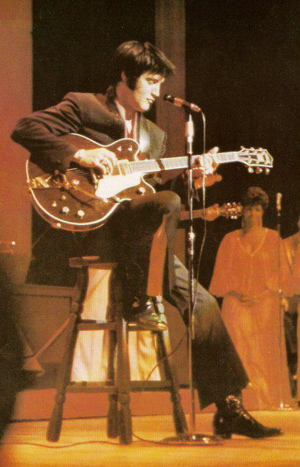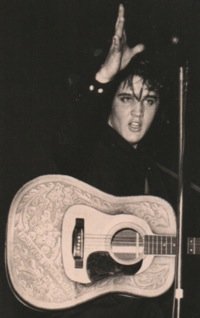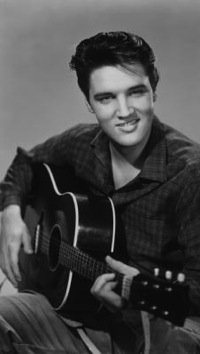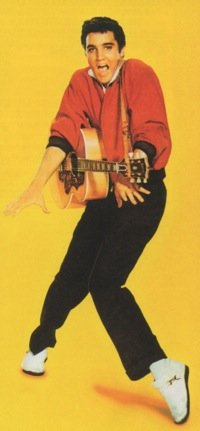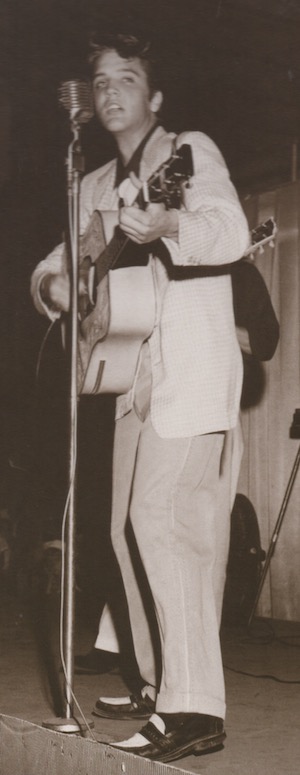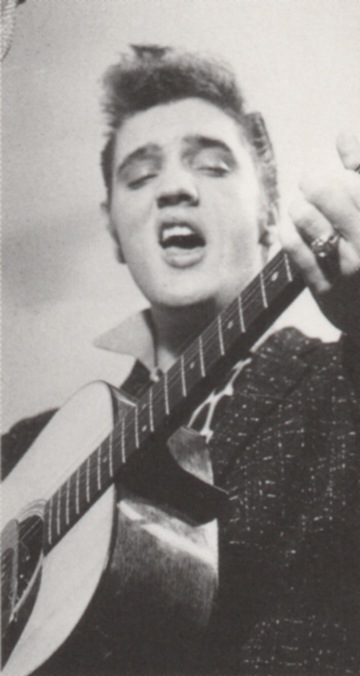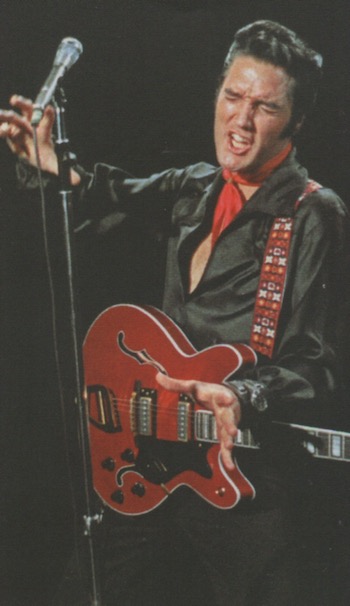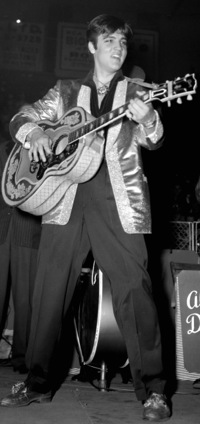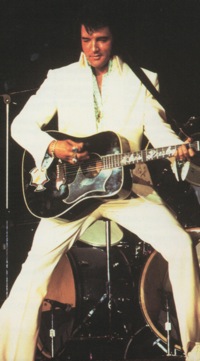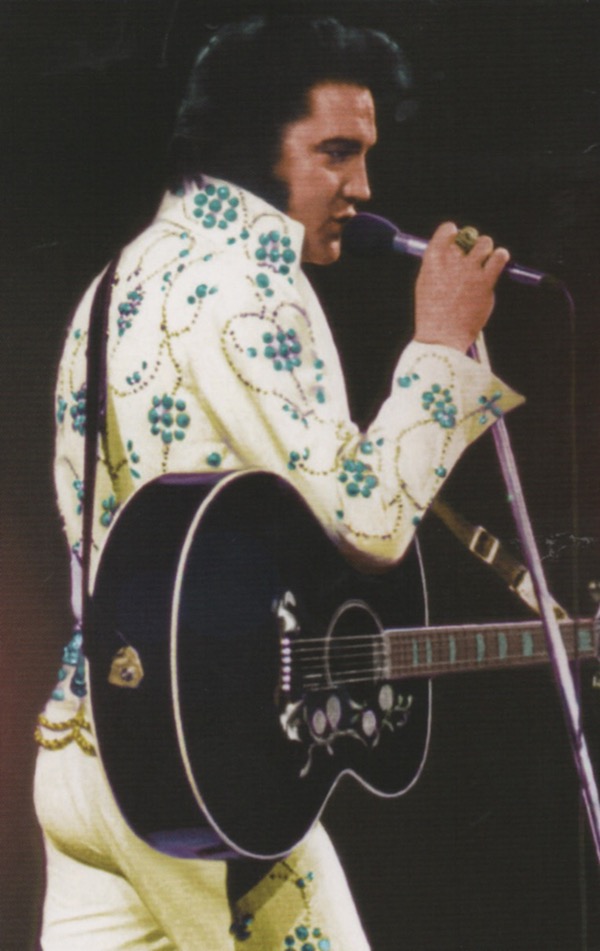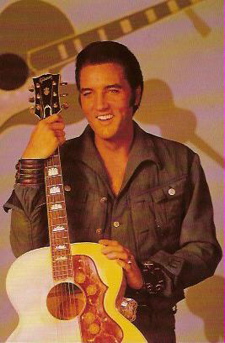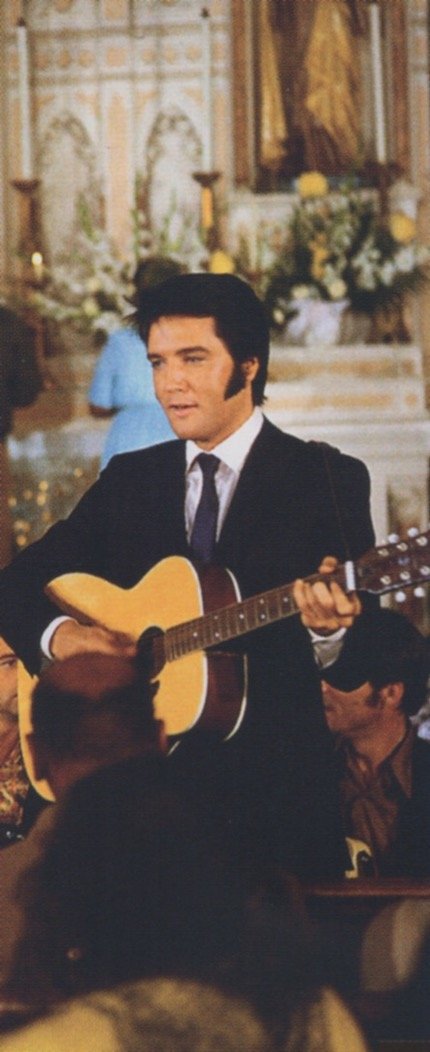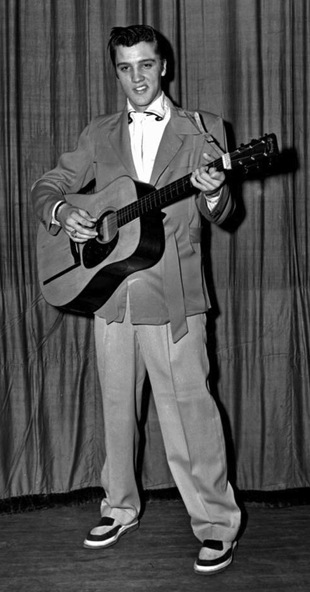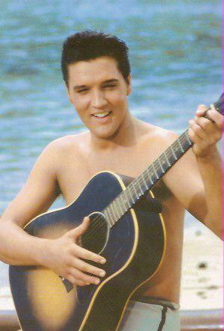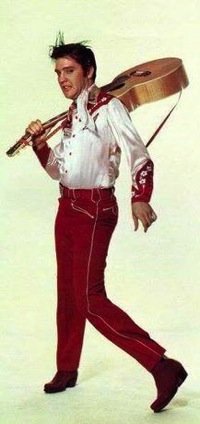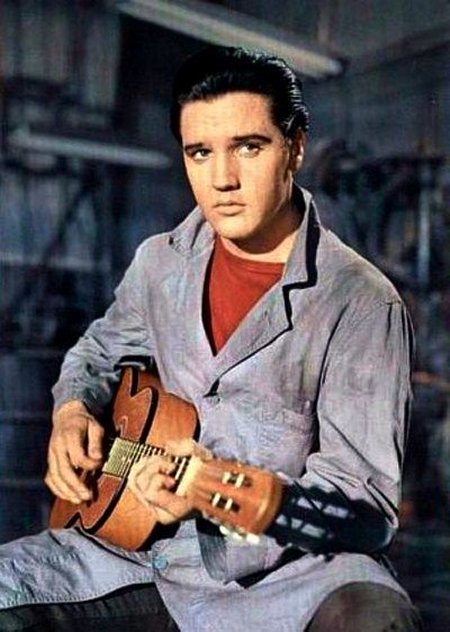Elvis History Blog
Elvis the Guitar Man:
Was He a Player or a Pretender?
“My daddy had seen a lot of people who played guitars and stuff and didn’t work, so he said: ‘You should make up your mind either about being an electrician or playing a guitar. I never saw a guitar player that was worth a damn.’” — Elvis Presley
The photograph on his first record album in 1956 shows Elvis Presley immersed in a rock ’n’ roll moment—eyes closed, mouth screaming, legs spread apart, and a right hand, almost in a fist, about to deliver a blow to six defenseless guitar strings. It’s an iconic image, with the guitar, the enduring rock instrument, at its center.
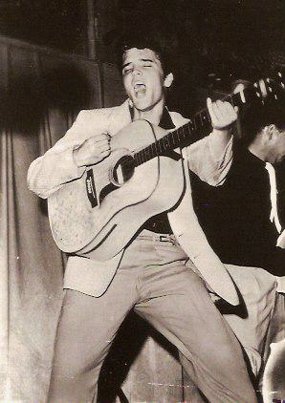
But is the photo an honest depiction of the young Elvis Presley? The soon to be anointed “King of Rock ’n’ roll” certainly had the pipes to wear the crown, but did he have the ability to handle rock’s most fundamental tool? Could Elvis Presley really play the guitar, or was it just a prop in his rock ’n’ roll act?
Finding the answers to those questions requires going all the way back to Elvis’ eleventh birthday in 1946. Legend has it that he really wanted a bicycle for his birthday, but he got a guitar instead. It was a cheaper option for his poverty-stricken parents, and his mother sold the switch to her son by asking, “Wouldn’t you really rather have a guitar to use when you sing?”
As a toddler, Elvis began singing in church, and kept it up on other days of the week into his early years in school. Vocally, Elvis had some natural talent that became apparent to his schoolmates in his teen years. Blending the sounds of the country vocalists, white crooners, and black rhythm and blues artists that he heard on the radio helped him develop the unique vocal sound that would make him famous.
Young Elvis did not have a similar natural ability when it came to playing the guitar, though. That first guitar, described by one of his first instructors as a “little, itty-bitty, Gene Autry-type guitar,” became young Elvis’ constant companion, physically as well as musically. A beginner’s book introduced him to the concept of chords, but he needed some instruction from real guitar pickers.
Uncle Vester and Gladys’s brother Johnny Smith showed the boy a few chords. The Presley family’s new pastor, Frank Smith, furthered Elvis’ education. “I went over to his house a time or two, or he would come to where I was, and I would show him some runs and different chords from what he was learning out of his book.”
• Elvis started to learn how to play the guitar right
After the Presleys moved to Memphis, Jesse Lee Denson, son of a family friend, also gave Elvis some instruction. In Peter Guralnick’s Elvis biography, Jesse remembered Elvis’s first guitar.
“He couldn’t press the strings down on it, they was set so high. So I let him practice on mine—I had a little Martin. I just tried to show him basic chords. I would take his fingers and place them, say, ‘You’re pressing the wrong strings with the wrong fingers,’ trying to straighten him out. He couldn’t really complete a song for a long time, couldn’t move his fingers and go with the flow of the music, but once I straightened him out he started to learn to do it right.”
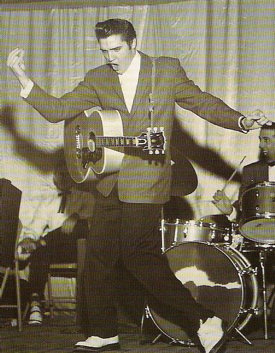
Denson later would see Elvis sitting on the steps of his family’s apartment playing and singing for friends. Often his guitar playing couldn’t keep up with his singing. Scotty Moore remembers how Elvis dealt with the problem. “If he lost his way, he threw up his hands in exasperation and said with a sheepish grin, ‘I forgot the chords.’" Scotty Moore’s ghostwriter, James Dickerson, added, “When he saw that got a laugh, he started doing it even when he knew the chords. Anything for a laugh. Music was a means to an end. It was attention he really wanted.”
Elvis’ high school classmate Red West told Guralnick a story that demonstrated how important Elvis’s guitar was to him then.
“One of the projects we had in wood shop was to bring an article from home that needed to be repaired … Elvis brought a guitar. And he fooled around with it, sanded it, used some rosin glue and fixed a crack in it, stained it, varnished it, then he took this real fine steel wool to get all the bubbles out of the lacquer and bring it down to a satin finish so it looked really good. Then he put the strings back on it and was tuning it just before the period ended.”
• Elvis took his guitar to Sun Records
A couple of months after graduation in 1953, Elvis used his fundamental guitar skills to accompany himself recording “My Happiness” and “That’s When Your Heartaches Begin” for his mother at Sam Phillips’s Memphis Recording Studio. It was the voice, not the guitar playing, that the receptionist later recommended to Sam.
That led to Elvis, Scotty Moore, and Bill Black meeting at Scotty’s house on July 4, 1954. Scotty’s wife Bobbie recalls seeing Elvis coming up the walk. “He had on a white lacy shirt, pink pants with a black stripe down the legs, and white buck shoes. He was carrying a guitar.” Neither Scotty nor Bill was impressed with either Elvis’s singing or playing, but they later agreed to try recording something with him at Sam’s studio.
The result was the historic recording session that launched Elvis’ career. Dickerson summarized Scotty’s remembrance of the event:
“Around midnight they took a break. It was late and they all had to go to work the next day … They had sort of lulled themselves into a post-session stupor when Elvis suddenly jumped up and started playing his guitar. Actually, as Scotty remembers it, he beat the hell out the guitar. He started singing a blues song, ‘That’s All Right, Mama.’ … The uptempo tune hit home with Scotty. Fast music was what he liked. For years he had been making up guitar licks for uptempo music, a combination of finger slides and bent-string pauses, but he had found nowhere to put them. It wasn’t until Elvis was flailing away at his guitar that he suddenly knew where those licks belonged.”
Despite his limited ability, Elvis Presley’s guitar work was the key component in that first recording. His playing inspired Scotty and Bill to join in. Scotty later noted, “Elvis didn’t know all that many chords, but he had a great sense of rhythm.”
• The Blue Moon Boys Rising
And so The Blue Moon Boys were born—Scotty playing lead, Elvis pounding the rhythm, and Bill slapping the bass. Elvis played guitar on all eight of the trio’s Sun recording sessions in 1954-55. “With only the three of us, we had to make every note count,” Scotty said. That applied not only to the studio but also to the dozens of personal appearances The Blue Moon Boys made over the next year and a half.
Scotty and Bill helped Elvis learn how to handle his guitar on stage. “They coached him on how to hold his guitar and do all this stuff in front of a mike,” explained Bill’s wife Evelyn.
After Elvis started to accumulate a little money in 1954, he splurged and bought himself a new guitar. He got $8 trade-in on his old one for a 1942 Martin guitar that cost $175. Guralnick reported, “He had his first name spelled out in black metallic letters across the blond wood of the D-18, just as he had on his old guitar. It came out smartly on a diagonal below the fret board, and the guitar looked a lot more professional than his other one, but, Elvis joked, he flailed away at it just the same.”
When country singer Bob Luman saw Elvis perform on stage in 1955, he noticed that Presley used his guitar more as a prop than as a musical instrument:
“This cat came out in red pants and a green coat and a pink shirt and socks, and he had this sneer on his face, and he stood behind the mike for five minutes, I’ll bet, before he made a move. Then he hit his guitar a lick, and he broke two strings. Hell, I’d been playing ten years, and I hadn’t broke a total of two strings. So there he was, these two strings dangling, and he hadn’t done anything except break the strings yet, and these high school girls were screaming and fainting and running up to the stage, and then he started to move his hips real slow like he had a thing for his guitar.”
June Carter Cash, who toured with Elvis in those early days, also remembered those broken guitar strings. “Red (West) and I used to sit backstage and try to change those strings because Elvis kept breaking them all the time. We spent all our time stringing that guitar and keeping it in tune.”
• Presley’s guitar work diminished with RCA
When Elvis started recording for RCA in 1956, experienced session guitar players, such as Hilmer J. “Tiny” Timbrell, were added to the mix of musicians in the studio. This resulted in a more professional sounding instrumental track and freed Elvis to concentrate on his vocals. Still, “Elvis Presley” was officially credited with playing the guitar at almost all of his recording sessions from 1956 through 1958. (Colonel Parker may have insisted on this to get Elvis paid a few extra bucks as a session musician in addition to what he earned for his vocals.)
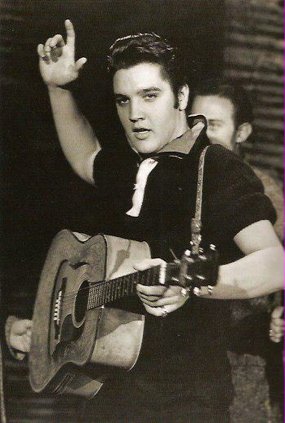
One 1950s recording on which Elvis is known to have played is “(You’re So Square) Baby I Don’t Care” for the Jailhouse Rock soundtrack. The story has been told often of how a frustrated Bill Black threw down his electric bass and stormed out of the studio. Jordanaire Gordon Stoker described what happened next:
“Most artists would have said, ‘You pick that bass up and play it, buster, that’s your job,’ but not Elvis. You know what Elvis did? Elvis thought it was funny. He picked it up and played it himself. He just picked up that bass, put his foot up on a chair, and played that song all the way through.”
Although Elvis didn’t play guitar on most of his recordings in the fifties, he often used his guitar to prepare for recordings. For instance, he used his guitar to work out an arrangement for “Hound Dog” at RCA’s New York studio on July 2, 1956. Also, he can be heard adding a percussion element by slapping the back of his guitar on the released takes of “Don’t Be Cruel” and “All Shook Up.”
• Presley’s guitar faded away in the sixties
That need to have a guitar at hand in the studio came up again when Elvis’s first post-army recording sessions approached in 1960. When Scotty Moore was at Graceland soon after Elvis returned home from the army, Elvis complained about how ragged his old J-200 guitar looked. Scotty used his endorsement deal with Gibson to order Elvis a new one. In a letter accompanying the order, Scotty instructed, “I would like for you to do some extra inlay work on the front, nothing too elaborate, something a little different possibly that he would like very much. I will leave the design of this to your discretion.” The new guitar was shipped to Nashville in time for Elvis’ session there.
In the 1960s, Elvis was seldom listed as a guitar session player in that decade’s RCA and movie soundtrack recording sessions. He was credited for the 1960 “Elvis Is Back” and 1961 “Something for Everybody” sessions, but after that there was no Elvis Presley credit as a guitar musician for 25 straight recording sessions from 1961 through 1967.
In a 1965 newspaper article, Elvis fessed up about his guitar playing ability:
“People seem to think I’m married to the guitar but the truth is I’m not very good at it. I usually get credited with beating up a storm on it, but usually I have another and much better guitar player backing me up when I play it. For me the guitar has just been something to do with my hands and beat time with. What I’m really studying to play is the drums.”
The author of the article concluded with the following: “Elvis says he is virtually abandoning the instrument with which he long has been identified.”
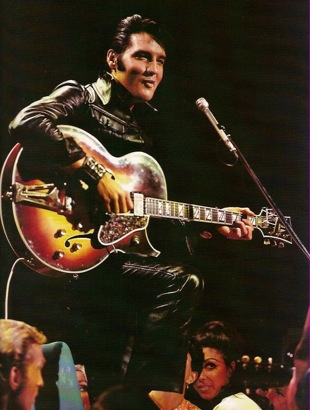
• Elvis “flogs” Scotty Moore’s guitar
However, there was one more classic Presley guitar moment in his career. Elvis asked Scotty Moore to participate in the memorable “sit-down” jam session for Presley’s 1968 NBC-TV special. Dickerson relates Scotty’s story of what happened.
“When they walked out on stage, their guitars were already in place. Scotty had his Gibson 400 Sunburst and Elvis had his Gibson J200, a natural-grain flattop model that Scotty had obtained for him from the manufacturer. They began the show with some of their early material … During the first couple of songs, Elvis kept glancing at Scotty, who was sitting to his left. Scotty’s brightly colored guitar shone in the camera lights. It was bigger than Elvis’s guitar, it was better looking, and it sounded better than his guitar. Elvis decided he just had to have it.”
Also on the stage was drummer D. J. Fontana. He continues the story.
“Scotty was playing lead for a while and all of a sudden Elvis wanted to play lead. So he goes over and grabs Scotty’s guitar. I thought, ‘What are we going to do here.’ Scotty wasn’t very happy about that. Elvis was a flogger and I knew Scotty was afraid he’d scar up the guitar. It worked out, but oh boy, he doesn’t like anyone to touch that guitar.”
Dickerson added the story’s ending. “Elvis played Scotty’s guitar for the remainder of the show… If Scotty was fuming on the inside, he never showed it. He kept going, never missing a beat … Elvis was the star, so he wanted the biggest, flashiest guitar.”
So, was the King of Rock ’n’ Roll a real guitar player, or just a pretender wielding a prop? Either way, the perception lives that he was, and they say “perception is reality.” For me, it all goes back to what James Dickerson wrote about the young Elvis Presley strumming his guitar on his front porch in Memphis.
“Music was a means to an end. It was attention he really wanted.”
Alan Hanson | © November 2015
Reader Comment: On the Comeback Special, Elvis played “One Night” and “Baby What You Want Me To Do,” both times almost the same way. So I feel Elvis was mostly a background type strummer, much like myself. Enough to back up when he was singing. — Den (June 2018)
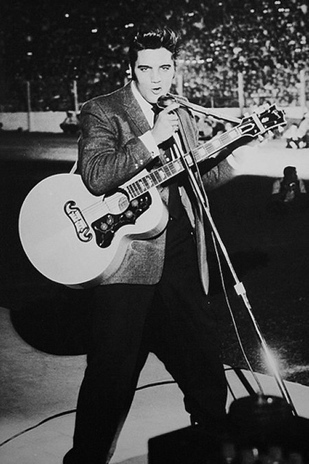
"Despite his limited ability, Elvis Presley’s guitar work was the key component in that first recording. His playing inspired Scotty and Bill to join in. Scotty later noted, 'Elvis didn’t know all that many chords, but he had a great sense of rhythm.'"
